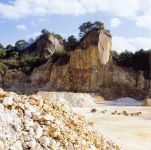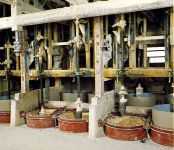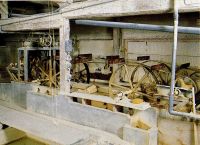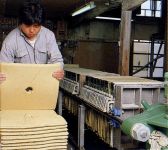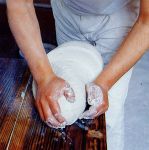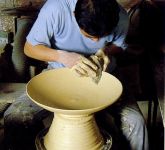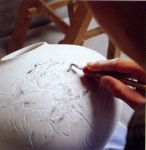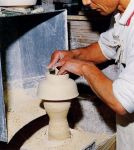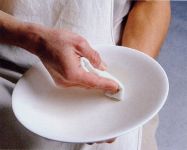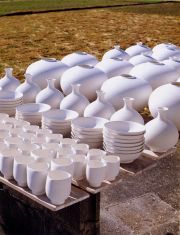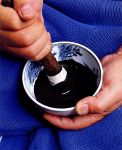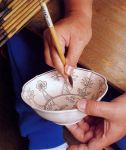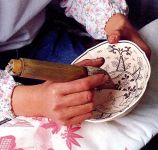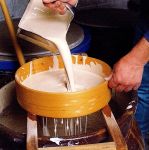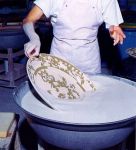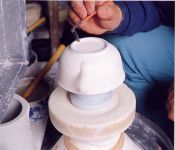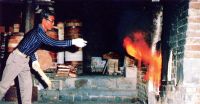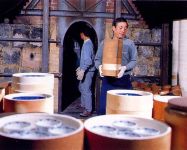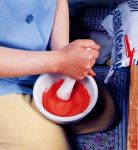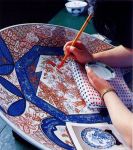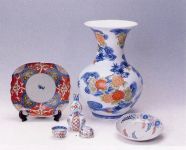| | | 1, Quarrying
Kaolin rocks of Izumiyama are opencut. The rocks are washed in water, cracked with a hammer, and sorted according to the quality of their cracked surfaces. Today, kaokin rocks from Amakusa are also used. |
| | | |
| | | 2, Crushing
Kaolin rocks are crushed, then ground to fine powder with a stamper. |
| | | |
| | | 3, Precipitating and filtering
First, kaolin powder is mixed with water. Then the solution is precipitated and its supernatant flued flows in a long tank and is filtered with a fine mesh to remove iron ingredients and other impurities. Thus good kaolin clay is obtained, which is easy to form. |
| | | |
| | | 4, Filter-pressing
Extra water is removed to meke clay of adequate firmness. |
| | | |
| | | 5, Clay kneading
Clay has to be kneaded well to blend its particles and moisture and to remove all bubbles. Articles made of well-kneaded clya will not crack or distort when fired. |
| | | |
| | | 6, Forming
This is the most important operation in the entire process of porcelain manufacturing. Most of Arita’s porcelain is formed by using lathes. |
| | | |
| | | 7, Body decorating
Various decorative techniques such as carving, lines engravig by using a comb, cutting holes, adding small knobs, etc…,are performed on the articles at the appropriate degree of dryness. |
| | | |
| | | 8, Paring
At this stage, the formed articles are still moist and must be finished by hand paring. According to the shapes of the articles, bottom rim paring, surface paring, knob making, edge finishing, and other finishing touches are added. |
| | | |
| | | 9, Wiping
The surfaces of the articles are carefully wiped with wet cotton cloth or deer slin until extremely smooth, before the under-glazing and glazing are applied. |
| | | |
| | | 10, Drying
If the articles are dried quickly, cracks may occur due to shrinkage. So the articles are put on long boards and allowed to dry in the shade or the sun.
11, Low-firing
Prior to high-firing, the articles are low-fired. The temperature inside the kiln is gradually raised in order to avoid damaging the articles. Low-firing is done at 900 centigrade.
12, Removal from kiln
The low-fired articles are gradually cooled in the kiln, and then taken out and carefully inspected. |
| | | |
| | | 13, Underglaze mixing
The most important operation of the porcelain painters is to determine how to mix the underglaze with water. There are two kinds. One is for drawing (outlining patterns) and the other is for painting (filling in or shading the pat terns). |
| | | |
| | | 14, Underglazing (drawing)
“Gosu” is used as blue underglaze. The main ingredient is cobalt oxide. After firing gosu turns blue. Low-fired articles absorb water, so that it is difficult to draw or paint on their surfaces with brushes. The quality of the finished porcelain is determined by the Painter’s skill. |
| | | |
| | | 15, Underglazing (painting)
Big brushes are used to apply the blue paint inside the patterns. Some parts are shaded. This technique is called “dami”. |
| | | |
| | | 16, Glaze making
Glaze is a thin film covering the surface of the article which becomes glass after firing. Its ingredients are feldspar, Limestone, silica, ash from the “yusu” tree, and varipus other substances. |
| | | |
| | | 17, Glazing
Small articles are dipped in a glaze tank. Big articles are glazed by using a dipper called a “choppage” in Japanese, to pour the glaze over the object. |
| | | |
| | | 18, Glaze finishing
The glazed surfaces are carefully checked to be sure they are smooth. The glaze on the bottom of the article is pared or wiped off so that the article won’t adhere to the tools inside of the kiln during high-firing. |
| | | |
| | | 19, High-firing
When high-fired the clay and glaze are matured and porcelainezed, resulting in beautiful porcelain. There are three stages of high-firing. At first, kilns are gradually heated to 900 C., then rapidly heated to 1200 C. and finally the temperature reaches 1300 C.. |
| | | |
| | | 20, Removing from kiln
White porcelain without colored patterns called “hakuji” in Japanese, blue and white porcelain called “sometsuke”, celadon porcelain called “seiji” and dark blue porcelain called “ruri” are completely finished at this stage. The others require further processing described next. |
| | | |
| | | 21, Over-glaze mixing
There are many colors of over-glaze such as red, yellow, green, black, gold, silver and so forth. |
| | | |
| | | 22, Over-glazing
The over-glaze is painted on the vitrified glaze. Like under-glazing, the drawing technique and shading techniwue “dami” are also used here.
23, Fusing
Over-glaze is fused to the porcelain in kilns fired at a low temperature (720-830C.) |
| | | |
| | | 24, Products
Thus the finished porcelain is called “iroe”, “akae” and “some-nishiki” according to its pattern. |
| | | |
